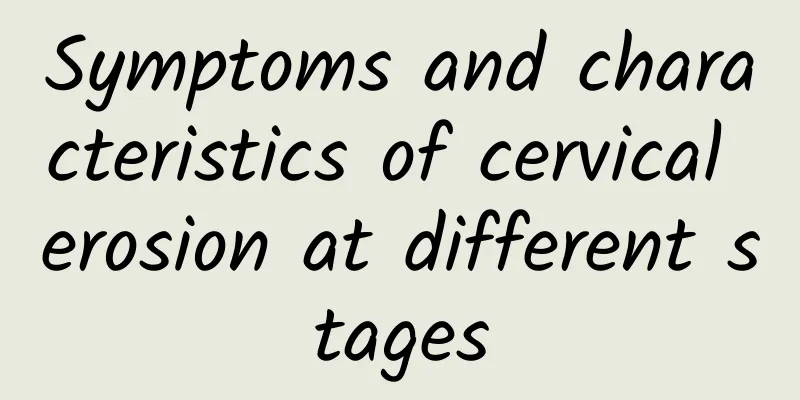Will cervical erosion affect fertility? How should women diagnose cervical erosion?

|
Although cervical erosion is a common disease, it must be treated in time, because if cervical erosion is not treated in time, the consequences will be very serious. So will cervical erosion affect pregnancy? Will cervical erosion affect fertility? Suffering from cervical erosion will not have much impact on fertility. Cervical erosion is divided into severe cervical erosion, moderate cervical erosion and mild cervical erosion. Different degrees of cervical erosion will have different impacts on women. For those with mild symptoms, there is no such thing as infertility. However, for those with severe cervical erosion, pregnancy will be affected to a certain extent. In fact, most cervical erosions are not true pathological erosions. Instead, under the regulation of fluctuating hormone levels, the external os of the cervix is covered by the surrounding columnar epithelium, forming a red area with a granular surface and a certain luster. It looks like real erosion, but it is actually just a normal physiological phenomenon, not a disease. The size of the cervical erosion area has different effects on the body. Cervical erosion with a smaller erosion area will not affect pregnancy. If it is just simple cervical erosion, there is no contact bleeding, abnormal leucorrhea, lower abdominal distension and other discomfort symptoms, and the cervical cytology examination is normal, you can get pregnant. Even if the patient with cervical erosion has mild inflammation, it will not affect conception, so the harm of mild cervical erosion does not affect fertility. Severe cervical erosion or clinical third-degree cervical erosion, second-degree cervical erosion accompanied by inflammation will have a certain impact on female fertility. If cervical erosion patients are accompanied by inflammation, such as purulent leucorrhea in the cervix, and infection with pathogens such as chlamydia or gonococcal infection, the cervical mucus will become thick and contain a large number of white blood cells, which is not conducive to the activity and penetration of sperm and will affect conception. What tests are needed for cervical erosion Cervical erosion is a serious problem for many female friends. Like many gynecological diseases, the early symptoms of cervical erosion are not very obvious, so it is very common to miss the diagnosis. For the health of women, regular gynecological examinations are necessary. So, what kind of examinations are needed for cervical erosion? 1. Gynecological examination. Focus on checking the size, shape, texture, thickness of the cervix, and whether there is contact bleeding. Then check the condition of the vulva, vagina, uterus, and paracervical tissues (ovaries, fallopian tubes, pelvic lymph nodes, etc.). 2. Cervical smear cytology examination is a routine gynecological examination. It is simple, easy, cost-effective, and the most important auxiliary examination and the preferred initial screening method for cancer prevention surveys. 3. Colposcopy can quickly detect lesions that are invisible to the naked eye. Taking biopsies from suspicious areas during colposcopy can significantly improve the accuracy of biopsies. 4. The iodine test and naked eye observation method are very simple and cheap, and can detect at least 2/3 of the lesions. As a preliminary screening method for cervical cancer, 3%-5% acetic acid solution is applied to the cervix. |
Recommend
Can I eat before abortion?
Generally speaking, artificial abortion refers to...
Problems with postmenopausal IUD placement
Among gynecological diseases, menopause is a comm...
What are the dangers of mild cervical hypertrophy
What are the dangers of mild cervical hypertrophy...
What are the causes of ovarian cysts?
What is an ovarian cyst? What are the causes of a...
Methods of auxiliary treatment for patients with vaginitis in winter
Vaginitis is the most common type of gynecologica...
How much does it cost to cure uterine effusion?
How much does it cost to treat uterine effusion? ...
Differential Diagnosis of Bacterial Vaginosis
Vaginitis, as a female disease, is very harmful t...
Small V-face is the most eye-catching. Remember the 4 acupuncture points for face slimming
The female stars on TV all have enviable small fa...
Tell you about the characteristics of several common painless abortions
In today's society, the best way to deal with...
How to deal with cervical erosion during pregnancy? 4 nursing matters for cervical erosion during pregnancy
Cervical erosion, a common gynecological disease,...
Can I exercise normally if I have vaginal candidal infection?
Active prevention of candidal vaginitis can avoid...
Women should pay more attention to the transmission route of adnexitis
In recent years, the incidence of adnexitis is st...
What medicine is effective for cervicitis and endometritis
Cervicitis and endometritis require appropriate d...
Beware of amenorrhea caused by premature ovarian failure before the age of 40
Ovarian dysfunction, unable to respond to gonadot...
What is the malignant transformation of uterine fibroids? What are the symptoms of malignant transformation of uterine fibroids?
What are the malignant changes of uterine fibroid...









